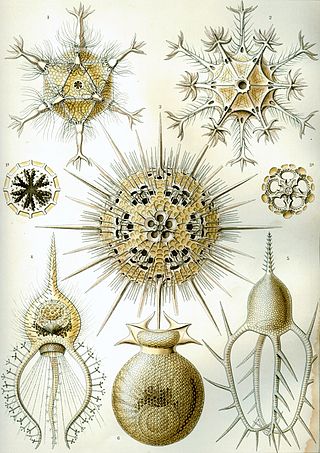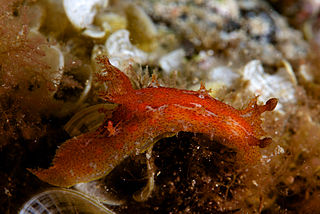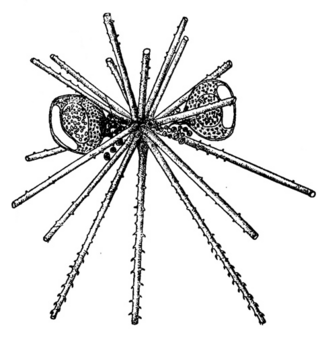
The Noctilucales are an order of marine dinoflagellates. They differ from most others in that the mature cell is diploid and its nucleus does not show a dinokaryotic organization. They show gametic meiosis.

Bioluminescence is the production and emission of light by living organisms. It is a form of chemiluminescence. Bioluminescence occurs widely in marine vertebrates and invertebrates, as well as in some fungi, microorganisms including some bioluminescent bacteria, and terrestrial arthropods such as fireflies. In some animals, the light is bacteriogenic, produced by symbiotic bacteria such as those from the genus Vibrio; in others, it is autogenic, produced by the animals themselves.

The Squaliformes are an order of sharks that includes about 126 species in seven families.

Siphonophorae is an order within Hydrozoa, which is a class of marine organisms within the phylum Cnidaria. According to the World Register of Marine Species, the order contains 175 species described thus far.
Glowworm or glow-worm is the common name for various groups of insect larvae and adult larviform females that glow through bioluminescence. They include the European common glow-worm and other members of the Lampyridae, but bioluminescence also occurs in the families Elateridae, Phengodidae and Rhagophthalmidae among beetles; as well as members of the genera Arachnocampa, Keroplatus and Orfelia among keroplatid fungus gnats.

Phaeodarea or Phaeodaria is a group of amoeboid cercozoan organisms. They are traditionally considered radiolarians, but in molecular trees do not appear to be close relatives of the other groups, and are instead placed among the Cercozoa. They are distinguished by the structure of their central capsule and by the presence of a phaeodium, an aggregate of waste particles within the cell.

Grantia is a genus of calcareous sponges belonging to the family Grantiidae. Species of the genus Grantia contain spicules and spongin fibers.
Siphonosphaera is a genus of radiolarians. The genus contains bioluminescent species. It is a genus of colonial radiolarians.

Plocamopherus is a genus of sea slugs, specifically nudibranchs, shell-less marine gastropod molluscs in the family Polyceridae, subfamily Triophinae. A unique character of Plocamopherus species is a globular bioluminescent organ at the tip of the pair of appendages which are placed just behind the gills. Many species are known to be nocturnal and several are from deep water. They feed on bryozoans.
Thalassicolla is a radiolarian genus reported in the Thalassicollidae. The genus contains bioluminescent species. It is a genus of solitary radiolarians.
Cytocladus is a radiolarian genus reported in the family Thalassothamnidae. The genus contains bioluminescent species.

Collozoum is a radiolarian genus formerly reported in the subfamily Sphaerozoidae, now reported descending from the order Collodaria. The genus contains bioluminescent species. It is a genus of colonial radiolarians.
Rhaphidozoum is a radiolarian genus reported in the subfamily Sphaerozoidae. The genus contains bioluminescent species. It is a genus of colonial radiolarians.

Acrosphaera is a radiolarian genus in the Collosphaeridae. The genus contains bioluminescent species. It is a genus of colonial radiolarians.

Collosphaera is a radiolarian genus in the family Collosphaeridae. The genus contains bioluminescent species. It is a genus of colonial radiolarians.
Rosacea is a genus in the Prayidae. The genus contains bioluminescent species.
Myxosphaera is a radiolarian genus in the Collosphaeridae. The genus may contain bioluminescent species. It is a genus of colonial radiolarians.
Tuscaridium is a genus of phaeodarian,. The genus contains bioluminescent species. It one of two known bioluminescent phaeodarean genera, the other being Aulosphaera.

Astracantha is a genus of planktonic phaeodaria and the only member of the family Astracanthidae. They are an unusual family of marine protists, but can be found across all oceans, from tropical to Arctic and Antarctic waters.











